SKIN
Skin Resurfacing
Skin resurfacing technology has improved radically since the early 1990's. Previous techniques, such as chemical peels or dermabrasion, have been complemented by laser techniques for the treatment of scars and wrinkles.
All of these technologies, to different degrees and by different methods, remove the upper layers of skin where fine lines and superficial scars exist. Chemical peels do this (to different depths based on the specific peeling agent) chemically, laser resurfacing vaporizes the upper layers and dermabrasion mechanically planes down the layers of skin. Once removed, elements from the deeper portions of the skin heal the wound, only in a smoother fashion.
Other light based treatments, such as Intense Pulsed Light (IPL) or Nd-YAG lasers, can be used to remove age spots, spider veins and broken capillaries, reverse sun damage, permanently reduce unwanted hair or tighten the skin.
Laser resurfacing and chemical peels can efface the fine lines and wrinkles of the face. Additionally, the skin "tightens" over time, giving an additional "lift". Skin resurfacing can be performed on specific areas, such as around the eyes, the cheeks, forehead or the mouth or over the entire face. These photos show the before and after appearance after a medium chemical peel.
Shown here are before (left) and after (right) views of actual patients. Remember, every patient responds differently to surgery, and no one can be certain that he or she will get the results shown. However, these photos will illustrate the changes that are possible with these procedures. Click on the images to view them in a larger window.
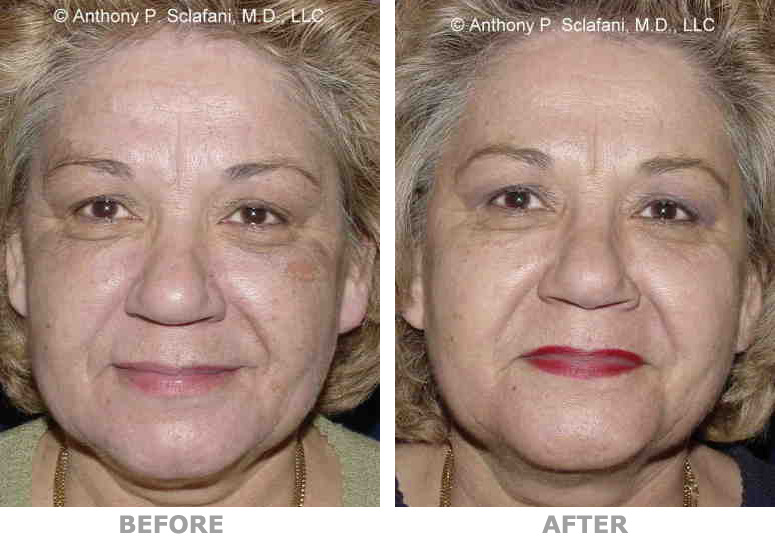
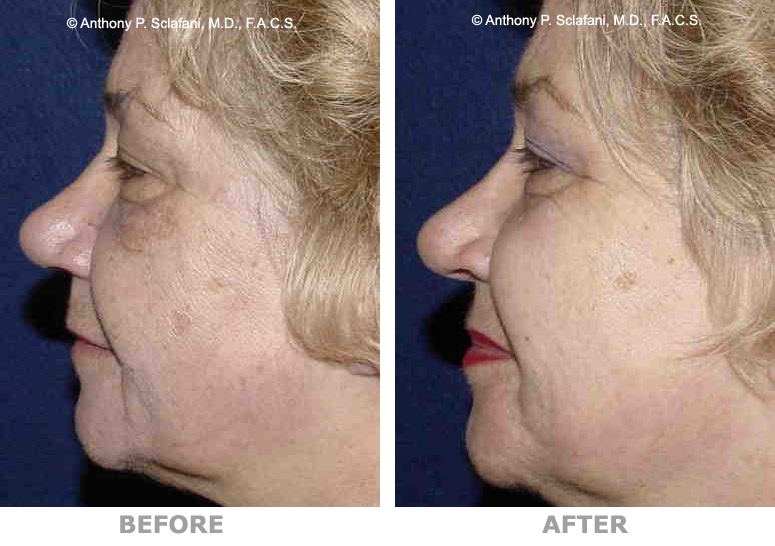
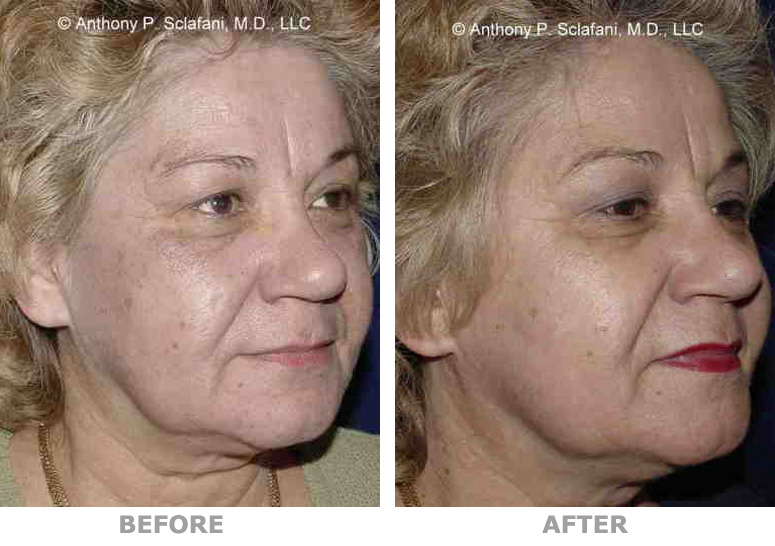
Intense Pulse light therapy is an excellent way to control reddish discoloration and is useful in the treatment of rosacea.

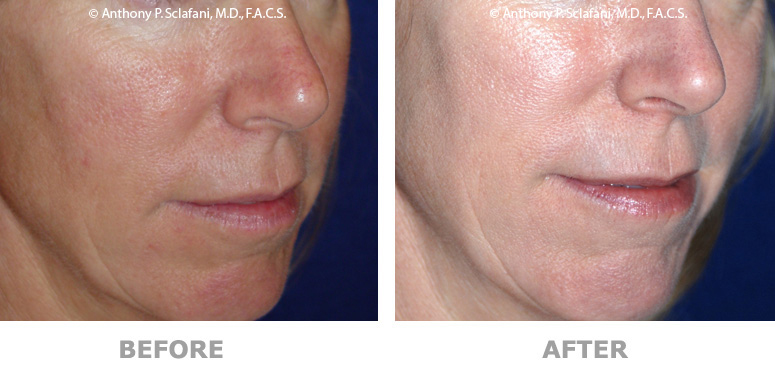
Dark red spots, especially those associated with scars, can be treated easily with an Nd-YAG laser.
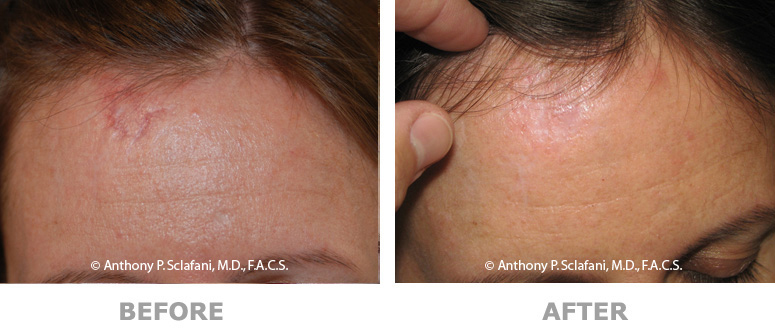
Skin Resurfacing - Process and Procedure
The Process
Chemical peels vary in their effect based upon the type and strength of the agent used. The lightest of these are the alpha hydroxyl acids (AHAs), which can be found in better commercial skin lotions and creams. Alpha hydroxyl acids, when used as part of a comprehensive daily skin care regimen, can gently exfoliate dry and rough skin. Medical-strength AHA peels, like glycolic acid peels, use stronger concentrations than those performed at salons and produce a noticeable softening and smoothing of the skin. They are often useful in cases of mild acne as well.
More potent peels, such as the "Blue Peel" or the trichloroacetic acid (TCA) peel, penetrate more deeply. These peels can help even complexion, soften fine lines (especially around the eye and mouth) and smooth skin. Laser resurfacing is generally reserved for more aggressive treatment of lines and wrinkles.
Skin resurfacing can be combined with a number of other procedures, and works especially well with blepharoplasty, brow lift, and in limited areas, with a facelift. Properly performed, laser resurfacing can smooth and tighten the skin rapidly without any incisions or scars. Intense Pulsed Light or Nd-YAG treatments can be tailored to the patient's skin and skin problems without causing damage to the outer layers of the skin. This means there is little to no recovery time.
The Procedure
Medical strength AHA peels take as little as 20 minutes to perform, and produce a light blush in the skin; make-up can be applied immediately, and there is no "down-time" afterwards.
The more potent peels, such as the TCA peel, are performed in the office as well; discomfort is limited to a brief "stinging" during the procedure, and "down-time" is limited to 4-6 days of skin peeling.
Laser resurfacing vaporizes the upper layers of skin without damaging the surrounding tissue. Once the upper layers of the skin have been removed, the deeper structures in the skin assist in healing the abraded area. There is some evidence that laser treatment stimulates new collagen production in the deeper areas of the skin, tightening and restoring elasticity to the treated skin.
In order to prepare your skin to obtain the best results from your laser resurfacing, you may be pre- treated with a vitamin A derivative (such as Retin-
A (Renova) or tazarotene) and/or a glycolic acid home product for 1- 4 weeks prior to the treatment. This prepares the skin for the peel, and may assist in achieving a better final result. You will also be treated with an antiviral medication prior to and after the peel to prevent cold sore flare- ups following treatment.
Intense Pulsed Light and Nd-YAG laser treatments take advantage that certain wavelengths of light will pass through the outer layers of skin without causing damage. Within the deeper layers of the skin, these light based treatments can target dilated blood vessels, age spots, sun damage, and unwanted hair. Treatments can be quick and effective with little to no recovery time.
What to Expect After Skin Resurfacing
Certain physical changes are expected following laser resurfacing. Some individuals experience all of the following and others only some. The degree to which each person is affected is variable and unpredictable.
Intense Pulse Light and Nd-YAG laser treatments
Intense Pulse Light and Nd-YAG laser treatments may leave the treated skin slightly pink for up to an hours, but this generally fades quickly, and there is rarely any swelling. Desired changes in texture or color occur gradually over a few weeks and treatment can be repeated as soon as 3 weeks. Sun protection for the first 2-3 weeks after treatment is important with both modalities to ensure the best results.
Glycolic Acid Chemical Peel
After a glycolic acid peel, no special aftercare is needed. Make-up can be applied immediately. As the skin exfoliates over the next week, it may require more moisturizer. If you have been using any lotions or creams containing glycolic acid, these should be avoided for the first 48 hours after the peel.
Obagi Blue/TCA Chemical Peels and Laser Resurfacing
DIET
It is best to start with liquids (soup, juices, etc.) immediately after surgery. Once the anesthesia has worn off and your appetite returns, regular food is allowed.
SKIN CARE
It is important that treated areas be kept moist at all times. A thin, but complete, layer of antibiotic ointment should be applied to all treated areas and maintained 3 to 4 times a day. Wash your face with a gentle soap 3 to 4 times a day, pat dry and reapply the ointment afterwards. Continue this treatment until instructed by the doctor.
ACTIVITY AFTER SURGERY
In order to allow your tissues to heal properly, we ask that you refrain from brisk physical activity for one week. Walking and non-physical activities are allowed, but it is best not to exercise for the first week. After the first week, aerobics, running, stair climbing, exercise bicycling and treadmills are permitted, but weight lifting (free weights or machines) should not be done until after the end of the second week after surgery. However, once the effects of the anesthetics have worn off, it is not necessary to remain in bed or at home. You may shower as soon as the effects of the anesthetics have worn off and you can comfortably stand on your own.
FLAKING/OOZING/CRUSTING
Flaking and crusting in the treated areas is to be expected for 5 to 7 days (chemical peel) or 7 to 10 days (laser resurfacing). Do not pick at these crusts. Areas that show light pink skin no longer need to be covered with an antibiotic ointment like Polysporin. During these first 5 to 7 days (chemical peel) or 7 to 10 days (laser resurfacing), direct sun exposure must be avoided.
SKIN COLOR CHANGE
Once the crusting ends, the skin will be pink for 2 to 6 weeks (chemical peel) or 8-12 weeks (laser resurfacing). Once the crusting is gone, the pink skin can be covered with cosmetics. Your skin is extremely sensitive to the sun during this time period, and you must be extremely cautious about sun exposure. Direct sunlight must be avoided, and sunscreen of SPF 30 or greater should be used daily and reapplied often during the day. Hormone medications will also affect the pigmentation of the treated skin; please discuss this with the doctor before resuming these medications. Dark (tan or brown) coloration to the treated areas can be faded with a creme; it is important to begin this as soon as possible.
FEVER
You may experience a flushed sensation in the treated area, or all over, after the surgery, but a temperature greater than 101º is unusual.
SWELLING
Your face may become swollen for 2-3 days (chemical peels) or 7 days (laser resurfacing). This is normal. Elevating your head as much as possible will help reduce swelling and make you more comfortable.
PAIN
Your face may feel sunburned the night of the treatment. This resolves rapidly and, for most people, there is very little discomfort as the treated skin heals. You will be given a prescription for pain medication, although most patients need only Tylenol.
TIGHTNESS
Your face may feel tight during the initial healing period because of swelling. After your skin has healed it may feel more taut. This is normal and usually is not uncomfortable.
SUN SENSITIVITY
Your treated skin will always be more sensitive to the sun. Therefore, adequate sun protection in the form of wide-brimmed hats and sunblocks will always be necessary to avoid sunburn or skin irritation from the sun.
MILIA
Milia (tiny white bumps) may appear on your facial skin. These represent trapped oil glands. Observe these for 48 hours. If there is no improvement, they can be easily treated in the office.
